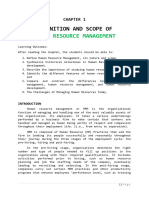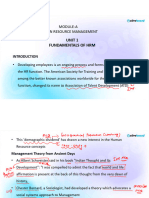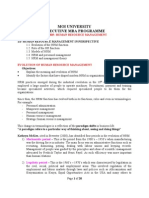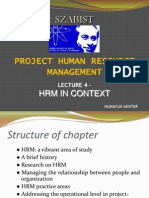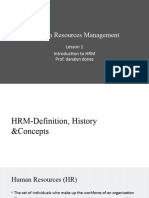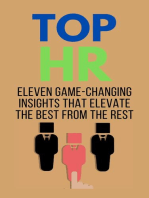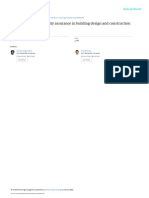0 ratings0% found this document useful (0 votes)
13 views1 Basic Concepts of HRM
1 Basic Concepts of HRM
Uploaded by
Suraz Thapa MagarHuman resource management has evolved over time from personnel management to address strategic needs. Key factors driving its development include technological changes, globalization, and the need to effectively manage talent. The goals of HRM are to support organizational objectives, ensure a skilled workforce, and create a positive employment relationship. HRM functions include recruiting and developing talent as well as maintaining ethical policies and managing change.
Copyright:
© All Rights Reserved
Available Formats
Download as PPT, PDF, TXT or read online from Scribd
1 Basic Concepts of HRM
1 Basic Concepts of HRM
Uploaded by
Suraz Thapa Magar0 ratings0% found this document useful (0 votes)
13 views15 pagesHuman resource management has evolved over time from personnel management to address strategic needs. Key factors driving its development include technological changes, globalization, and the need to effectively manage talent. The goals of HRM are to support organizational objectives, ensure a skilled workforce, and create a positive employment relationship. HRM functions include recruiting and developing talent as well as maintaining ethical policies and managing change.
Copyright
© © All Rights Reserved
Available Formats
PPT, PDF, TXT or read online from Scribd
Share this document
Did you find this document useful?
Is this content inappropriate?
Human resource management has evolved over time from personnel management to address strategic needs. Key factors driving its development include technological changes, globalization, and the need to effectively manage talent. The goals of HRM are to support organizational objectives, ensure a skilled workforce, and create a positive employment relationship. HRM functions include recruiting and developing talent as well as maintaining ethical policies and managing change.
Copyright:
© All Rights Reserved
Available Formats
Download as PPT, PDF, TXT or read online from Scribd
Download as ppt, pdf, or txt
0 ratings0% found this document useful (0 votes)
13 views15 pages1 Basic Concepts of HRM
1 Basic Concepts of HRM
Uploaded by
Suraz Thapa MagarHuman resource management has evolved over time from personnel management to address strategic needs. Key factors driving its development include technological changes, globalization, and the need to effectively manage talent. The goals of HRM are to support organizational objectives, ensure a skilled workforce, and create a positive employment relationship. HRM functions include recruiting and developing talent as well as maintaining ethical policies and managing change.
Copyright:
© All Rights Reserved
Available Formats
Download as PPT, PDF, TXT or read online from Scribd
Download as ppt, pdf, or txt
You are on page 1of 15
Basic Concepts of HRM
• Liberalization and globalization along with the
advancements in informational technology has
brought to center stage the importance of
human resources
• In a competitive scenario, effective utilization of
human resources has become necessary and the
primary task of organizations is to identify,
recruit, and channel competent human resources
into their business operations for improving
productivity and functional efficiency.
• Effective utilization of human resources would lead to
both accomplishment of individual goal and
organizational goals and creation of assets at the
national level and become vital for the very survival,
growth, and development of the organizations
• Management has been defined as development of
people ; the process of decision making and control
over actions of human beings; planning, organizing,
and controlling of people and resources. The process
of accomplishing the desired organizational objectives;
effective utilization of available resources for delivery
of goals and services etc.
• Then HRM can be defined within this backdrop.
HRM is the function performed in organizations
that facilitates the most effective use of people
to achieve individual and organizational goals.
The common use of term to describe unit or
department concerned for people in
organizations are personnel, HRM, industrial
relations, employee development etc. In some
organizations, human resources management
functions are still performed under the
‘personnel department’.
• Human resource management is concerned with all
aspects of how people are employed and managed in
organizations
• It covers activities such as strategic HRM, human
capital management, knowledge management ,
corporate social responsibility, organizational
development, resourcing( workforce planning,
recruitment, selection, and talent management)
learning and development, performance and reward
management, employee relations, employee
wellbeing, and the provision of employee services
The goals of HRM
• support the organization in achieving its
objectives by developing and implementing HR
strategies that are integrated with the business
strategy
• contribute to the development of a high –
performance culture
• ensure that the organization has talented,
skilled, and engaged people it needs
• create a positive employment relationship
between management and employees and a
climate of mutual trust
• Encourage the application of an ethical
approach to people management
• ensure and create the environment of
organizational adoption coping with change
factors
Hard and Soft HRM
• Storey(1989) has made a distinction between Hard and Soft HRM
• The hard approach focuses on the quantitative and strategic
aspects of managing human resources. It is rational approach,
which deals with human resources like any other economic factor.
It emphasizes the need for managing people to enhance their
contribution to improve the quantitative advantage of the
organization
• The soft approach to HRM, whose roots can be traced to human
relation school, emphasizes factors such as communication,
motivation, and leadership. It treats employees as the essential
means of realizing organizational objectives rather than more
objects. It focuses on engendering commitment among employees
by winning their hearts
HRM functions:
• Helping the organization reach its goals.
• efficiently employing the skills and abilities of the
workforce
• providing well-trained and well motivated employees
• increasing employee’s job satisfaction and self
actualization
• achieving quality of work life
• communicating HRM policies to all employees
• maintaining ethical policies and socially responsible
behavior
• managing change
• managing increased urgency and faster cycle time
Development of HRM concepts
• HRM concepts as we understand today – dates
back to 400 BC(Chaldeans Inventive plan)
Babylonian codes or Hammurabi around 1800 BC.
The Chinese as early as 1650 BC had originated
the principle of division of labor(specialization).
The span of management and the related
concepts of organization were well understood
by Moses around 1200 BC. In India, Kautilya
observed a sound base for systematic
management of human resource as early as 4th
century.
• prior to Industrial revolution, the status of labour was
extremely low and the human relationships between
employer and the employees were characterized by
slavery, serfdom, and guild system
• Slavery was based on negative incentive , and serfdom
was based on positive incentive system
• But both the system were replaced with the growth of
manufacturing and commercial enterprises by the guild
system,. Guild system marked the beginning of human
resource management for selection, training ,and
development of workers and emergence of collective
bargaining for wages and working conditions.
• The Industrial revolution followed by the new economic
doctrine of Lasseiz faire, which deteriorated the employer-
employee relationship due to unhealthy work environment,
long working hours, fatigue, monotony, strain etc
• reviewing the history, it is observed that after first world
war(1917), personnel management discipline emerged as a
new field of knowledge which made business expansion,
labour strategies, and higher rates to employee etc. But
great depression again threw many personnel's out of jobs
and this created a disillusion for the profession. And again
after depression , the business profession had reached the
stage of maturity and organizations started giving
importance to it like other core functions, viz. production
and marketing
• Thus the evolution of HRM can be traced back to the
HR movement in the modern age, that is, up to 1930’s
it was referred to as personnel management and the
focus was on employer- employee relation. Studies on
HR were initially guided by Taylor’s scientific
management principles and then graduated through
the Howthorne studies to the behavioural school
based on the theories of Abraham Maslow, Herzberg,
and Douglas MacGregor etc. In this 21st century,
further development in this field has brought by the
arrival of new knowledge's and IT era
Factors which are responsible for
development of HRM
• Technological changes
• Rising competition
• The rise of consumerism, government
protection
• Social changes
• The political development , restructured
trade unions
• The structural change in employment etc
Characteristics of HRM
• Explicit relation between HRM and business
strategy
• Increases employee commitment
• Recognition of common interests and needs
• Responses for influences of social, economic,
political and cultural contexts
• Increase in the role of line managers
• A normative approach etc
HR challenges
• Managing change
• Leadership development
• learning and development
• staffing challenges
• succession planning and building the talent pipeline
• Measurement of employee effectiveness
• war for talent
• Retaining and rewarding top level employees
• Building an attractive culture
• Responding to globalization
• workforce diversity
• keeping work-life balance and flexibility
• aging workforce and generation gap
• Better compensation
You might also like
- Chapter 1. Introduction To HRMDocument12 pagesChapter 1. Introduction To HRMkiomy355No ratings yet
- Why Are We Losing All Our Good PeopleDocument6 pagesWhy Are We Losing All Our Good PeopleNaif Al-Baloushi100% (2)
- QBO Cert Exam Module 1Document68 pagesQBO Cert Exam Module 1Nikka ella LaraNo ratings yet
- Principles of HRMDocument22 pagesPrinciples of HRMSufyan Ranjha100% (1)
- Human Resource Management: by Deribe A. (PHD)Document35 pagesHuman Resource Management: by Deribe A. (PHD)Getnat BahiruNo ratings yet
- Mba Lecture 1Document31 pagesMba Lecture 1Floride ACCALOGOUNNo ratings yet
- Human Resource Management MBSDocument43 pagesHuman Resource Management MBSRA T NA BCNo ratings yet
- HRMDocument252 pagesHRMdworth549No ratings yet
- Basic Concept of HRMDocument30 pagesBasic Concept of HRMSuman PoudelNo ratings yet
- Introduction To Human Resource Management: Mission Vision Core ValuesDocument36 pagesIntroduction To Human Resource Management: Mission Vision Core ValuesRohit GoyalNo ratings yet
- Chapter I - An Overview of HRMDocument28 pagesChapter I - An Overview of HRMDemissie DaleloNo ratings yet
- Basic Concept of HRMDocument29 pagesBasic Concept of HRMJohn O LawalNo ratings yet
- Module 1 - HRMDocument24 pagesModule 1 - HRMSathyanarayanan KalyanasundaramNo ratings yet
- C 1 HRM IntroductionDocument65 pagesC 1 HRM Introductionsanthosh prabhu mNo ratings yet
- OLG 111 Introduction to HRM and Management ThoughtDocument34 pagesOLG 111 Introduction to HRM and Management Thoughtdenis mwaisanilaNo ratings yet
- HRM Unit 1Document30 pagesHRM Unit 1hokasov495No ratings yet
- Unit 1 Introduction To Human ResourceDocument37 pagesUnit 1 Introduction To Human ResourceJONATHAN SINKALANo ratings yet
- Nature and Scope of HRM IIIDocument26 pagesNature and Scope of HRM IIIParul Jain100% (1)
- Chapter One - Project Human Resource ManagementDocument27 pagesChapter One - Project Human Resource Managementgetahun tesfayeNo ratings yet
- Human Resource Management unit 1 & 2Document144 pagesHuman Resource Management unit 1 & 2deepa buddyNo ratings yet
- Module 1Document12 pagesModule 1supriyajay02csNo ratings yet
- Module 1 HRMDocument22 pagesModule 1 HRMHarshNo ratings yet
- HRM Chap. One PPT2023Document30 pagesHRM Chap. One PPT2023AddisNo ratings yet
- Human Resources Management: Introduction To HRMDocument34 pagesHuman Resources Management: Introduction To HRMpoorvithpoorvith439No ratings yet
- Notes HRM 2023 - 040126Document47 pagesNotes HRM 2023 - 040126Yusuph HajiNo ratings yet
- Introduction to Human Resource Managemen1-1Document4 pagesIntroduction to Human Resource Managemen1-1emperorsalleNo ratings yet
- HRM Chapter 1Document36 pagesHRM Chapter 1Alazar TeferiNo ratings yet
- HRM IntriductionDocument22 pagesHRM Intriductionaggrey.aggreyNo ratings yet
- Unit 1 FinalDocument24 pagesUnit 1 FinalGajendra JaiswalNo ratings yet
- The History of Human Resource ManagementDocument7 pagesThe History of Human Resource ManagementFarahZahidiNo ratings yet
- HCM-Module 1Document16 pagesHCM-Module 1Shagufta ShowkatNo ratings yet
- Uint-1 2Document27 pagesUint-1 2arorarishantaroraNo ratings yet
- Lecture 1 - IntroductionDocument41 pagesLecture 1 - IntroductionDinh Thi Tu Linh (FGW HN)No ratings yet
- Fundamentals of HRM-1 2.42090Document26 pagesFundamentals of HRM-1 2.42090shirishbbk8360No ratings yet
- TOPIC 1 Changing Roles of HR Professionals (CHP 5 Marchington Et Al 2021)Document41 pagesTOPIC 1 Changing Roles of HR Professionals (CHP 5 Marchington Et Al 2021)2024541723No ratings yet
- Human Resource ManagementDocument30 pagesHuman Resource ManagementTejas DangodraNo ratings yet
- Evolution of HRMDocument1 pageEvolution of HRMnabeeraaaaNo ratings yet
- BHR 7205 - Human Resource Management AssignmentDocument13 pagesBHR 7205 - Human Resource Management Assignmentdanielkoshj47No ratings yet
- Human Resource ManagementDocument16 pagesHuman Resource Managementsumit_rockNo ratings yet
- Bacc2 RevDocument2 pagesBacc2 RevKath ParNo ratings yet
- Human Resource Management: Prof. Nidhi RaiDocument26 pagesHuman Resource Management: Prof. Nidhi RaifreebookNo ratings yet
- HRM Module 1 EditedDocument18 pagesHRM Module 1 EditedMrs. Zhang YixingNo ratings yet
- MBA 820 Evolution of HRMDocument20 pagesMBA 820 Evolution of HRMelinzola80% (5)
- Szabist: Project Human Resource ManagementDocument19 pagesSzabist: Project Human Resource ManagementAyaz QaiserNo ratings yet
- HRM PPT Chapter 1Document18 pagesHRM PPT Chapter 1Birhanu AberaNo ratings yet
- Human Resource Management: Topics To Be CoveredDocument17 pagesHuman Resource Management: Topics To Be Coveredaparajita02No ratings yet
- Topic 1 PresentationDocument28 pagesTopic 1 Presentationfrancis MagobaNo ratings yet
- Human Resource Departments Can Influence The Behaviour of Employees. Identify and Discuss Specific Ways by Which This May Be AchievedDocument15 pagesHuman Resource Departments Can Influence The Behaviour of Employees. Identify and Discuss Specific Ways by Which This May Be AchievedAiyathurai RaveendranathanNo ratings yet
- Topic 1 - The Practice of Human Resource ManagementDocument73 pagesTopic 1 - The Practice of Human Resource ManagementFathimath RafshaNo ratings yet
- Chapter 1 HRMDocument22 pagesChapter 1 HRMMarc Franz R. BurceNo ratings yet
- Introduction To HRMDocument9 pagesIntroduction To HRMCosmas KipkoechNo ratings yet
- Human Resource Management: DefinedDocument5 pagesHuman Resource Management: DefinedLubnaskNo ratings yet
- Lecture 1 - IntroductionDocument14 pagesLecture 1 - IntroductionQuỳnh MaiNo ratings yet
- Human Resource Management: Unit 1Document65 pagesHuman Resource Management: Unit 1Rajender SinghNo ratings yet
- Introduction of Human Resources ManagementDocument27 pagesIntroduction of Human Resources ManagementJohanna Faith MontillaNo ratings yet
- 6 Human Resource Management and Recruitment and Selection WS 17-18Document47 pages6 Human Resource Management and Recruitment and Selection WS 17-18Amr ElSananNo ratings yet
- Human Resource ManagementDocument54 pagesHuman Resource Management28ammu6hariniNo ratings yet
- Unit 01 - Introduction To Human Resource Management - Manipal UniversityDocument24 pagesUnit 01 - Introduction To Human Resource Management - Manipal UniversityPraveen ParocheNo ratings yet
- IHRMDocument22 pagesIHRMtannubana810No ratings yet
- Superior Strategy in Human Resource Management: From Theory to PracticeFrom EverandSuperior Strategy in Human Resource Management: From Theory to PracticeRating: 5 out of 5 stars5/5 (1)
- Top HR: Eleven Game-Changing Insights That Elevate The Best From The RestFrom EverandTop HR: Eleven Game-Changing Insights That Elevate The Best From The RestNo ratings yet
- Ijm 10 06 062Document6 pagesIjm 10 06 062Nagarajan TNo ratings yet
- AP. Cash and Cash EquivalentsDocument3 pagesAP. Cash and Cash EquivalentsGia Sarah Barillo BandolaNo ratings yet
- ABC COMPANY financial statementDocument2 pagesABC COMPANY financial statementmikejerichoparan2005No ratings yet
- Indicadores de Performance Seguridad - ADDocument20 pagesIndicadores de Performance Seguridad - ADPablo Di GregorioNo ratings yet
- Lianie Minny - CV Resume - 2023Document5 pagesLianie Minny - CV Resume - 2023lianieminnyNo ratings yet
- 7160 - FAR Preweek ProblemDocument14 pages7160 - FAR Preweek ProblemMAS CPAR 93No ratings yet
- Case Studies On Indian Financial InstitutionsDocument12 pagesCase Studies On Indian Financial InstitutionseshaNo ratings yet
- Paper IEIDocument6 pagesPaper IEIAssefa MogesNo ratings yet
- Mba 1 Sem Marketing Management 1 Kmb106 2020Document1 pageMba 1 Sem Marketing Management 1 Kmb106 2020Abhimanyu MalhotraNo ratings yet
- Short Cycle Analysis Business Case StudiesDocument1 pageShort Cycle Analysis Business Case StudiesMbalekelwa MpembeNo ratings yet
- Study - Id41589 - Estee Lauder Statista DossierDocument76 pagesStudy - Id41589 - Estee Lauder Statista Dossierkk1116100% (1)
- Test Bank: Human Resource Management, 9 EditionDocument19 pagesTest Bank: Human Resource Management, 9 EditionThuận PhạmNo ratings yet
- Present Worth Method of Comparison Lecture 7&8Document20 pagesPresent Worth Method of Comparison Lecture 7&8Hammad SattiNo ratings yet
- Guideline Assignment Entrepreneurship Bus3234dme3234acc3238-Sem 3 2021Document78 pagesGuideline Assignment Entrepreneurship Bus3234dme3234acc3238-Sem 3 2021Intan SyuhadaNo ratings yet
- Dissertation On Employee Resistance To ChangeDocument8 pagesDissertation On Employee Resistance To ChangePaperHelpSingapore100% (2)
- TallyDocument6 pagesTallySayandip MondalNo ratings yet
- Corporate Image: A Conceptual Framework For Strategic PlanningDocument10 pagesCorporate Image: A Conceptual Framework For Strategic PlanningAlina CiabucaNo ratings yet
- Trade Union Effort in Nepal A ReviewDocument11 pagesTrade Union Effort in Nepal A ReviewANO RVDNo ratings yet
- Management and Operations Maintenance For A Water Treatment and Supply CompanyDocument19 pagesManagement and Operations Maintenance For A Water Treatment and Supply Companyشوعي حرملNo ratings yet
- Problem Set 9 - Supply: Multiple Choice QuestionsDocument2 pagesProblem Set 9 - Supply: Multiple Choice QuestionsrajNo ratings yet
- Supply Chain Case StudiesDocument3 pagesSupply Chain Case StudiesbalashankarrNo ratings yet
- Mujtaba Khoja's Resume TorontoDocument2 pagesMujtaba Khoja's Resume TorontoMujtaba KhojaNo ratings yet
- Assam Bio Refinery Private Limited: AccountabilityDocument6 pagesAssam Bio Refinery Private Limited: AccountabilitySiva Ram kambapuNo ratings yet
- Ch16 Financial Statement AnalysisDocument134 pagesCh16 Financial Statement AnalysisLeigh Garanchon100% (3)
- Test Bank Chap 009Document19 pagesTest Bank Chap 009BẢO CHÂU GIANo ratings yet
- Presented By: Badani JasmineDocument16 pagesPresented By: Badani JasmineBhagirath Dogra100% (1)
- SAA Versus TAA 2009-01Document5 pagesSAA Versus TAA 2009-01domomwambiNo ratings yet
- Combined Time Table of Acc PDTD&CC PDTDM PGDTDCCDocument14 pagesCombined Time Table of Acc PDTD&CC PDTDM PGDTDCCVt waghmareNo ratings yet
